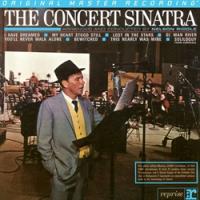Solemn Sinatra Scores on Goldwyn Soundstage
Back in 1963, Frank Sinatra, the brawling "rat packer," lounge-lizard wise-cracker took a short retirement to record this album of classic Broadway show tunes, with the emphasis on Rodgers and Hammerstein, lushly orchestrated by Nelson Riddle.
Back in 1963, Frank Sinatra, the brawling "rat packer," lounge-lizard wise-cracker took a short retirement to record this album of classic Broadway show tunes, with the emphasis on Rodgers and Hammerstein, lushly orchestrated by Nelson Riddle.
This was a risky undertaking for many reasons. For beginners, Sinatra did not have a big, barrel-chested Broadway-style voice. Back then Broadway singers were belters—there was no electronic augmentation as there is today. Broadway singers like Bonnie Raitt's dad John had big, robust voices that were trained to easily reach the balcony back row.
Would the unusually large orchestra overwhelm the voice? Would Sinatra's fans used to intimately recorded studio sessions and live concerts and recordings buy into this formal setting recorded on a cavernous soundstage?
True, it was Frank's own label so he didn't have outside pressure from the label executives. The only pressure was from within but this was pressure Sinatra brought upon himself as he roused himself from his usual comfort zone.
To get the full measure of the scene and set your own heart beating rapidly, open the gatefold jacket and take it all in.
The recital recorded on the Goldwyn Studios soundstage number 7, famous for its reverb characteristics, utilized the most sophisticated production techniques possible at the time. It was a multi-tracked recording using multiple 35MM dubbers normally used for film sound work. While 35MM recording techniques had been previously pioneered and used by Robert Fine and his team at Mercury Records, and by Bert Whyte for his Everest Records label, those were relatively simply miked affairs mixed "live" to two track 35MM magnetic stock.
Here, multiple synched dubbers recorded the sound, which was then mixed down for stereo vinyl release. The original 1/4" master was used for this vinyl release but a subsequent remix from the multi-track elements is planned for a future digital release by the Sinatra organization.
At around 31 minutes total, this is a relatively short album but it's hardly short of spectacular, memorably moments, like when Frank holds an impossibly long note during "Ol' Man River" that's guaranteed to take your breath away even if it didn't take his. While Sinatra's instrument wasn't immense, his power was and he used it when necessary to produce results larger than the physical instrument seemed capable of creating. His technique throughout—his phrasing, timing and breath control were impeccable. The recording lets you hear everything.
The album opens with the stately pre-romance song "I Have Dreamed" from "The King and I" complimented by swirling, cinematic strings and ending with a curtain call of a closing crescendo. Immediately obvious is the size of the space and the miking's respectful distance, particularly on the percussion.
Every song is a highlight. There are no throwaways. Sinatra breathes inspirational life into a Jerry Lewis telethon chestnut like Rodgers and Hammerstein's "You'll Never Walk Alone" from "Carousel" and he imbues "Ol' Man River" with civil rights era fire.
In "Soliloquoy," a song about fatherhood (also from "Carousel") that's partially sung and partially spoken, in which the singer first imagines he's going to have a son but soon realizes it might be daughter, one can easily imagine Sinatra considering his progeny. He first recorded the song back in the 1940s soon after becoming a father.
Sinatra singing with down to earth certainty and sincerity in front of Nelson Riddle's grand orchestrations is a combination that remains musically and emotionally timeless.
As effective as Sinatra's performance was, it could be argued that the real star here was Nelson Riddle. His arrangements, though hardly stylish by contemporary standards, remain fresh. Compare them to some produced for Tony Bennett or Ray Charles from the same era and that much is obvious.
Mobile Fidelity has done an excellent job with the nearly 50 year old tape. The original pressing manufactured using the then fresh tape has greater vocal transparency, but also sounds somewhat soft and ill-focused on the instrumentation and of course the new pressing is far quieter and produces a blacker backdrop.
The artistry of Frank Sinatra and Nelson Riddle combine to produce a classic album that was not one of Sinatra's biggest sellers when it was first issued, but the years have added luster to the package. Every play seems to reveal heretofore buried elements in Riddle's arrangements and expressiveness in Sinatra's interpretations.
Sinatra singing "art songs" from classic Broadway shows may have been a detour on his chosen career path, but it continues to have great substance and will provide a meaningful listening experience for as long as people listen to music for pleasure and for inspiration.
- Log in or register to post comments




